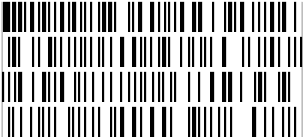Home
> urticator.net
Search
About This Site
> Domains
Glue
Stories
Computers
Driving
Games
Humor
Law
Math
> Numbers
Science
Powers and Fractions
Notes About Squares
Decimal Expansions (Section)
Number Maze
Primes
Divisibility
> Intrinsic Nature of Primes
Other Topics
Other Topics (2)
Other Bases
|
> Number Line |
Number Line
The second way of understanding is to use no base at all, and view the primes as points on a number line. Here's what the primes up to 1200 look like in that view.
In case that's not self-explanatory, the idea is that each row covers 300 numbers. So, for example, the symmetrical group at the start of the second row represents the primes 307, 311, 313, and 317.
That's a nice picture to look at, I think, but it doesn't lead much of anywhere … the only conclusion I can draw is that there are a lot of primes. I mean, I knew there were an infinite number of primes (which is a lot), but I also knew that large primes were scarcer than small ones, and somehow I always figured that once one got to 300 or so, primes would be pretty scarce. Clearly that's not the case!
In fact, the density of primes turns out to be roughly 1/ln x. Now, it's well known that ln x increases very slowly, so that 1/ln x decreases very slowly, but it's hard to grasp just how slowly it decreases. The best approach I've found comes from thinking about tableaux.
A tableau, remember, is a kind of diagram that describes a block of 30 numbers. There are eight boxes that represent the eight potential primes; of those, the ones that are composite are marked with Xs, while the rest, the actual primes, are left open. So, as the density of primes decreases, the number of Xs per tableau increases, to a maximum of eight.
Now, in the tableaux up to 600 (see Primes), the number of Xs per tableau seems to increase to just over three, …
01123 23233 42342 33633
… and in the tableaux from 600 to 1200 (see Three Digits), the number seems to increase to somewhere around four.
32444 35244 44433 42554
At that rate, you might think that by 2000 the number would reach five, and that by 10000 the tableaux would be almost completely full. Right?
Wrong, of course. To see what really happens, let's have N be the number of Xs per tableau, and solve to find the value of x where that density occurs. So … we start with 1/ln x = (8−N)/30, and find that x = e30/(8−N). Putting in the numbers, it turns out that N=3 occurs at 403, as expected, and that N=4 occurs at 1808, slightly later than expected, but that N=5 doesn't occur until much later, at 22026. Then the function explodes … to get to N=7 requires a fourteen-digit number!
N 30/(8−N) x 2 5 148 3 6 403 4 7.5 1808 5 10 22026 6 15 3.27×106 7 30 1.07×1013 7.5 60 1.14×1026
Of course, you have to remember that we're talking about the average value of N, not the actual values. For example, isolated tableaux with N=7 appear much earlier; the first is at 2490.
Finally, going back to the formula 1/ln x, here's a nice rule of thumb I came up with. Most n-digit numbers are closer in logarithm to 10n than to 10n−1, so the density of primes near a n-digit number is roughly 1/ln 10n, or 1/2.3n.
See Also
Associative Hooks
Reference Material
@ November (2004)
